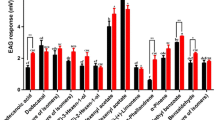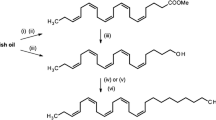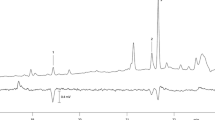Abstract
A mixture oftrans- andcis-11-tetradecenyl acetates have been found in omnivorous leafroller moth female tip extracts in a ratio of 88∶12, respectively. In the field they are the most attractive to male omnivorous leafroller moths in a ratio of 94∶6. Field attractancy can be increased by addition of small quantities (0.2–2.0%) of mixtures oftrans- andcis-11-tetradecenyl alcohols, indicated to be present in female tip extracts in a ratio of 88∶12, respectively.
Similar content being viewed by others
References
AliNiazee, M.T., andStafford, E.M. 1971. Evidence of a sex pheromone in the omnivorous leafroller,Platynota stultana (Lepidoptera: Tortricidae): laboratory and field testing of male attraction to virgin females.Ann. Entomol. Soc. Am. 64:1330–1335.
Baker, J.L.,Hill, A.S.,Cardé, R.T.,Kurokawa, A.K., andRoelofs, W.L. 1975. Sex pheromone field trapping of the omnivorous leafroller,Platynota stultana. Environ. Entomol. 4. In press.
Beroza, M., Muschik, G.M., andGentry, C.R., 1973. Small proportion of opposite geometric isomer increases potency of synthetic pheromone of oriental fruit moth.Nature 244:149–150.
Bierl, B.A., Beroza, M. andCollier, C.W., 1970. Potent sex attractant of the gypsy moth: its isolation, identification and synthesis.Science 170:87–89.
Cardé, R.T., Roelofs, W.L., andDoane, C.C. 1973. Natural inhibitor of the gypsy moth sex attractant.Nature 241:474–475.
Glass, E.H., andHervey, G.E.R. 1962. Continuous rearing of the red-banded leaf roller,Argyrotaenia velutinana.J. Econ. Entomol. 55:336–340.
Hill, A., Cardé, R., Comeau, A., Bode, W., andRoelofs, W. 1974. Sex pheromones of the tufted apple bud moth,Platynota ideausalis. Environ. Entomol. 3:249–252.
Hummel, H.E., Gaston, L.K., Shorey, H.H., Kaae, R.S., Byrne, K.J., andSilverstein, R.M. 1973. Clarification of the chemical status of the pink bollworm sex pheromone.Science 181:873–875.
Klun, J.A., Chapman, O.L., Mattes, K.C., Wojtkowski, R.W., Beroza, M., andSonnet, P.E. 1973. Insect sex pheromones: minor amount of opposite geometrical isomer critical to attraction.Science 181:661–663.
Kochansky, J.,Liebherr, J.,Cardé, R.T., andRoelofs, W.L. 1975. Sex pheromones of the European corn borer in New York.J. Chem. Ecol. 1. In press.
Mangold, H.K., andKammereck, R. 1961. Separation, identification and quantitative analysis of fatty acids by thin-layer chromatography and gas-liquid chromatography.Chem. Ind. 27:1032–1034.
Müller-Schwarze, D., Müller-Schwarze, C., Singer, A.G., andSilverstein, R.M. 1974. Mammalian pheromone: Identification of active component in the subauricular scent of the male pronghorn.Science 183:860–862.
Persoons, C.J., Minks, A.K., Voerman, S., Roelofs, W.L., andRitter, F.J. 1974. Sex pheromones ofArchips podana (Lepidoptera: Tortricidae): Isolation, identification and field evaluation of two synergistic geometrical isomers.J. Insect Physiol. 20:1181–1188.
Roelofs, W.L., andCardé, R.T. 1974. Oriental fruit moth and lesser appleworm attractant mixtures refined.Environ. Entomol. 3:586–588.
Roelofs, W., andComeau, A. 1971a. Sex pheromone perception: electroantennogram responses of the red-banded leaf roller moth.J. Insect Physiol. 17:1969–1982.
Roelofs, W., andComeau, A. 1971b Sex attractants in Lepidoptera, pp. 91–112,in A. S. Tahori (ed.), Proceedings of the 2nd International IUPAC Congress on Pesticide Chemistry, Tel Aviv. Vol. 3, Chemical releasers in insects. Gordon and Breach, New York.
Roelofs, W., Comeau, A., Hill, A., andMilicevic, G. 1971a. Sex attractant of the codling moth: characterization with electroantennogram technique.Science 174:297–299.
Roelofs, W., Hill, A., Cardé, R., Tette, J., Madsen, H., andVakenti, J. 1974. Sex pheromones of the fruittree leafroller moth,Archips argyrospilus.Environ. Entomol. 3:747–751.
Roelofs, W.L., Tette, J.P., Taschenberg, E.F., andComeau, A. 1971b. Sex pheromone of the grape berry moth: identification by classical and electroantennogram methods, and field tests.J. Insect Physiol. 17:2235–2243.
Sower, L.L., Vick, K.W., andTumlinson, J.H., 1974. (Z,E)-9, 12-Tetradecadien-1-ol: A chemical released by femalePlodia interpunctella that inhibits the sex pheromone response of maieCadra cautella.Environ. Entomol. 3:120–122.
Tette, J.P. 1974. Pheromones in insect population management. Pages 399–410in M.C. Birch (ed.), Pheromones. Elsevier Publishing Co., New York.
Thiessen, D.D., Regnier, F.E., Rice, M., Goodwin, M., Isaaks, N., andLawson, N. 1974. Identification of a ventral scent marking pheromone in the male mongolian gerbil (Meriones unguiculatus).Science 184:83–85.
Author information
Authors and Affiliations
Additional information
This work was supported by the Rockefeller Foundation and by NSF Grant No. GB 38020.
Rights and permissions
About this article
Cite this article
Hill, A.S., Roelofs, W.L. Sex pheromone components of the omnivorous leafroller moth,Platynota stultana . J Chem Ecol 1, 91–99 (1975). https://doi.org/10.1007/BF00987722
Issue Date:
DOI: https://doi.org/10.1007/BF00987722




